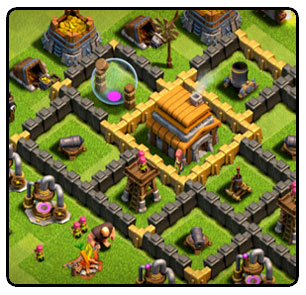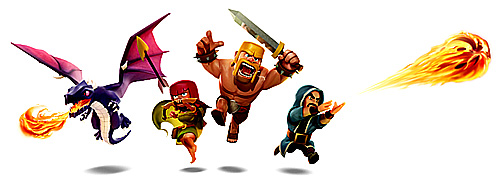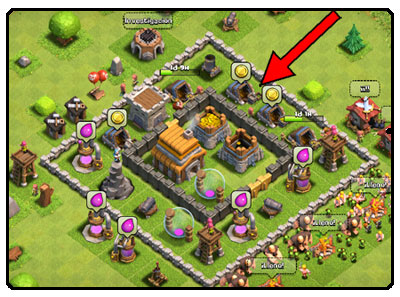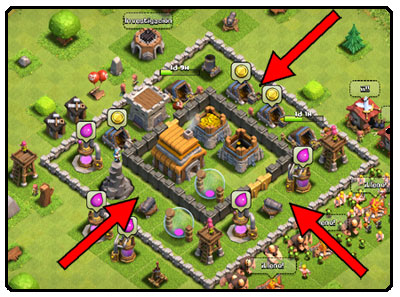Clash of Clans Attack Strategy | ||
| ||
There are several factors to consider when planning to attack enemy clans. The goal is to minimize loss while maximizing reward. Chief Executive Officers of major companies call this ‘risk versus reward’ plan. The reason for such a plan is because with every plan there is always a cost (investing money, changing personnel, moving operations, …) and there is reward (new revenue, better public relations, growing a larger pool of customers, …). For the purposes of Clash of Clans, we will examine areas relevant to the game. Here are the sections in this part of the tutorial:

| ||
When you are contemplating whether or not you want to attack an enemy clan, leaping in with your giants and barbarians before you look can be extremely detrimental. We have to consider what the enemy clan has to offer. We have to examine their available resources. If an enemy has low resources, why would we want to expend our resources and time to defeat this enemy? There has to be either a great deal of gold or elixir or both, else there is no point to attack. We have to dismiss enemies who have little resources for us to plunder.
The next section will examine several scenarios to better flesh out this important facet of the game.
| ||
The amount of forces you should expend can be calculated using a risk versus reward system (called Linear Programming in mathematics). Before attacking a clan, look to see how much gold and elixir are available. If there is only 1000 elixir to be gained, don’t waste more than 1000 elixir in troop value.
Scenario A Sure, sometimes you are going to want to exact revenge on the clan that just raided your village and took all your gold. However, if your revenge places you at a greater loss of resources, your enemies win yet again. Do not hand your enemies such a hollow victory. Let’s take a look at another scenario and run the numbers using the same costs mentioned within scenario A.
Scenario B
This could be a good amount of resources, if we play our cards right. If we expend only giants and barbarians, there is a formula we could use to help determine how much to spend. If we use ‘x’ for the number of giants, ‘y’ for the number of barbarians, and ‘z’ for the number of archers, it would cost us 250x for the giants, 40y for the barbarians, and 80z for the archers. This is a total of… 250x + 40y + 80z This total has to be less than what we plan to gain, namely the 15,000 value. There are several combinations of troop deployment we can use to gain the 15,000 value without wasting a lot of elixir trying to rebuild our forces after the battle. We could use 8 giants, 10 barbarians, and 10 archers, like so. 250(8) + 40(10) + 80(10) is equal to 2000 + 400 + 800, which is equal to a 3200 cost. Even if we attacked with two wall breakers for an additional cost of 2000 elixir (1000 elixir each) to make a total cost of 5200 and have a tidy profit, if we win. We could use 10 giants, 15 barbarians, and archers, like so. 250(8) + 40(10) + 80(10) is equal to 2000 + 400 + 800, which is equal to a 3200 cost. Even if we attacked with two wall breakers for an additional cost of 2000 elixir (1000 elixir each) to make a total cost of 5200 and have a tidy profit, if we win.
Scenario C
 We may decide to attack with 10 giants, 20 barbarians, and 4 balloons and use a cost formula of… 250x + 40y + 2000z, where ‘x’ stands for the number of giants, ‘y’ stands for the number of barbarians, and ‘z’ stands for the number of balloons. Calculating would give us:
250(10) + 40(20) + 2000(4) is equal to 2500 + 800 + 8000, which is equal to a cost of 11,300. This is well under the value of 65,000, making this enemy a worthwhile target.
| ||
There are numerous strategies for dealing with troop placement. These strategies usually depend upon:
If your enemy is poorly fortified (see Defenses: Bad), then it is best to find the least defended area and attack all forces there. Pound your enemy by unleashing all forces at one point so that your forces can destroy cannons and towers, one at a time. See the picture below.
 If your enemy is not poorly fortified (see Defenses: Good and Genius), then greater care must be taken. Instead of placing all your forces in one area, it may actually be beneficial to spread out your forces in several zones of attack. The reason for splitting your forces is that the defending player’s actively defensive weapons will also attack separately. With a single line of attack, enemy cannons and towers will concentrate against individual troops and dispatch them without much effort. By attacking in several directions, these same defensive weapons become weaker when divided, which will give your troops more time to attack. See the picture below.

If you are looking to simply scoop up as many resources as the defending clan has to offer, attacking in several directions appears to have better success. Blowing a hole in the defending player’s wall can lead to a swarm of your barbarians and goblins. Choosing points of entry close to the defending player’s most densely packed zone that contains resources is best. Your rampaging horde will attack the nearest targets, which should be those resources you are coveting.
|
 Let’s consider a situation where your troops have these costs: barbarians (level 2) cost 40, archers (level 2) cost 80, giants (level 1) cost 250, and goblins (level 2) cost 40. Attacking with four giants would cost 1000 elixir. If you won, there would be no profit. Likewise, attacking with two giants, five barbarians, three archers, and one goblin would cost you 980 elixir. This would amount to no meaningful profit if you won with this puny attack force.
Let’s consider a situation where your troops have these costs: barbarians (level 2) cost 40, archers (level 2) cost 80, giants (level 1) cost 250, and goblins (level 2) cost 40. Attacking with four giants would cost 1000 elixir. If you won, there would be no profit. Likewise, attacking with two giants, five barbarians, three archers, and one goblin would cost you 980 elixir. This would amount to no meaningful profit if you won with this puny attack force.
 5,000 + 10,000 = 15,000 elixir.
5,000 + 10,000 = 15,000 elixir.